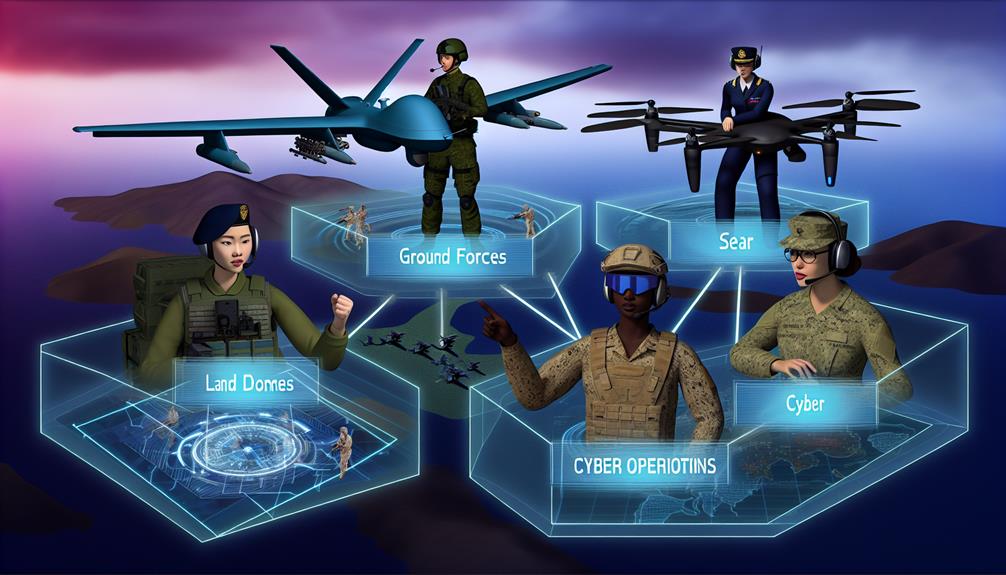Consider a scenario where a military unit seamlessly coordinates air, ground, and cyber operations to neutralize a threat in real-time. You might wonder how such synchronization is achieved and the underlying strategies that make it possible. Mastering Multi-Domain Operations (MDO) isn't just about technology; it requires a thorough understanding of domain management and command structures. As you explore the intricacies of this approach, you'll uncover the essential components that shape effective military responses in today's complex landscape.
What is a Domain Controller and Can a Domain Controller Have Multiple Domains?
A Domain Controller (DC) plays a critical role in managing authentication and security within a Windows Server environment.
Within a multi-domain forest, a DC can oversee multiple domains, each with distinct policies and user settings while facilitating resource sharing.
Understanding how DCs function in this framework is essential for optimizing security and operational efficiency across your organization.
Role of Domain Controllers in Multi-Domain Operations
In a multi-domain environment, Domain Controllers play a vital role in managing user access and security policies across different domains.
You can leverage a single Domain Controller to handle multiple domains within an Active Directory Forest, streamlining administrative tasks while maintaining distinct security settings.
This setup not only enhances security but also allows for tailored permissions that align with your organization's operational needs.
Domain Controllers in Multi-Domain Environments
Domain controllers serve as the backbone of resource management within a specific domain, ensuring that access is efficiently controlled and monitored.
In multi-domain environments, these domain controllers can manage multiple domains, tailoring policies and permissions for enhanced flexibility.
Multi-Domain Operations
Understanding the types of Multi-Domain Operations is vital for effective military strategy in today's complex environment.
You'll need to grasp how Multi-Domain Formations and Command Concepts work together to enhance operational effectiveness.
Additionally, recognizing the functions of a Multi-Domain Operations Center will equip you to better respond to evolving threats.
Types of Multi-Domain Operations
In understanding Multi-Domain Operations (MDO), it's essential to recognize the various types that shape how military forces engage in complex environments.
You should consider these four key types of MDO:
- Joint Operations – Integrating capabilities across different branches of the military.
- Interagency Operations – Collaborating with civilian agencies for a unified approach.
- Allied Operations – Working alongside international partners to enhance collective security.
- Cognitive Operations – Focusing on information warfare and psychological tactics to influence adversaries.
Each type plays a pivotal role in achieving strategic objectives within the multi-domain framework.
MDO Multi-Domain Operations Overview
Multi-Domain Operations (MDO) revolutionize the way military forces engage adversaries by seamlessly integrating capabilities across land, air, sea, space, and cyber domains.
You'll notice that MDO emphasizes precision and adaptability, enabling high-velocity responses to complex threats.
Multi-Domain Formations
Harnessing the power of Multi-Domain Formations allows military forces to integrate capabilities across land, air, sea, space, and cyber domains, creating a synchronized approach to modern warfare.
These formations emphasize collaboration among various military branches, enabling a holistic strategy that counters threats in multiple domains simultaneously.
To effectively implement Multi-Domain Formations, consider these critical elements:
- Interoperability: Facilitate seamless communication and coordination among different branches to facilitate multi-domain command and control.
- Continuous Training: Regular drills and educational programs are essential for personnel to grasp the complexities of operations across diverse domains.
- Agility: Develop the ability to adapt swiftly to evolving battlefield conditions, allowing forces to respond to emerging threats.
- Cognitive and Cyber Integration: Incorporate cross-cutting sectors like cognitive and cyber domains into offensive and defensive planning to enhance overall effectiveness.
Multi-Domain Command Concepts
Understanding Multi-Domain Command Concepts is essential for your operational strategy.
These concepts integrate capabilities across various domains—air, space, land, sea, and cyber—enhancing effectiveness in complex environments.
Multi-Domain MCI
Effective command concepts are pivotal for maneuvering the complexities of modern warfare, where operations span air, space, and cyber domains.
Multi-Domain Command Concepts (MDC2) focus on integrating operational frameworks that enhance decision-making.
Functions of a Multi-Domain Operations Center
A Multi-Domain Operations Center (MDOC) plays an essential role in modern military strategy by uniting diverse operational domains—land, air, sea, space, and cyber—into a cohesive command structure. This centralized hub integrates and synchronizes operations, ensuring effective command and control across all domains.
The MDOC leverages advanced technologies to enable real-time data sharing, enhancing situational awareness and decision-making capabilities for commanders. You'll notice that personnel within the MDOC are trained to operate within a framework that emphasizes joint force cooperation and adaptability to rapidly evolving threats.
Regular assessments and wargames conducted by the MDOC refine operational concepts and improve command structures, fostering a culture of continuous learning and adaptability. By coordinating resources and capabilities, the center helps outpace adversaries, integrating both military and non-military instruments of power for a thorough operational approach.
Ultimately, the MDOC serves as the linchpin for executing multi-domain operations, ensuring that all elements of the military work in concert to achieve strategic objectives efficiently and effectively. Its functions are critical to maintaining operational superiority in an increasingly complex and interconnected battlespace.
Developing a Multi-Domain Strategy
To develop an effective Multi-Domain Strategy, you must focus on key components like operational concepts and advanced data-sharing technologies.
Understanding the advantages and disadvantages of these strategies will help you make informed decisions while implementing best practices for data management.
Additionally, examining case studies and emerging technologies can provide valuable insights into optimizing your approach in a rapidly changing operational landscape.
Key Components of a Multi-Domain Strategy
Crafting a successful Multi-Domain Strategy hinges on integrating operational concepts, technological advancements, and robust training. You must focus on coordinating efforts across land, air, sea, space, and cyber domains. This requires a clear framework that emphasizes command relationships and doctrinal guidelines, enabling effective synchronization of military operations.
Continuous refinement of command and control structures is crucial. Regular assessments and wargames allow you to adapt to the complexities of modern warfare environments, guaranteeing your strategy remains relevant.
Additionally, interconnectivity among various platforms is critical. By enhancing data sharing and improving networks, you're not just increasing situational awareness; you're also boosting decision-making capabilities during multi-domain operations.
Developing a new operational level command and control career field is essential. This guarantees personnel are equipped with the necessary skills and knowledge to execute future Multi-Domain Operations effectively.
To conclude, your multi-domain strategy should incorporate these key components, fostering an environment where forces can operate seamlessly across all domains, ultimately enhancing your overall operational effectiveness.
Advantages and Disadvantages of Multi-Domain Strategies
Frequently, multi-domain strategies present a dual-edged sword, offering both significant advantages and notable disadvantages.
On the positive side, these strategies enhance operational flexibility by allowing you to integrate capabilities across land, air, sea, space, and cyber domains. This integration enables simultaneous engagement of adversaries, creating a more layered defense and increasing deterrence. Advanced technologies facilitate real-time data sharing and interconnectivity, vital for synchronizing efforts against threats.
However, implementing multi-domain strategies isn't without challenges. You'll likely encounter cultural resistance within military branches, which can undermine coordination and communication among services.
It's also important to guarantee continuous training and education since institutional knowledge for command and control can quickly become outdated. Additionally, effective resource management and alignment among allied nations are necessary to guarantee seamless integration across all operational domains.
Best Practices for Multi-Domain Master Data Management
Successfully implementing multi-domain strategies hinges on effective Master Data Management (MDMD). To develop a robust multi-domain strategy, you need to integrate data across land, air, sea, space, and cyber domains. This thorough approach enhances your decision-making processes and guarantees you have a clear operational view.
Establishing a unified framework for data governance is essential. It assures consistency, accuracy, and accessibility, which are vital for successful multi-domain command. Collaboration among military branches is paramount; synchronize your data collection and sharing practices to foster interoperability. This enables rapid responses to evolving threats in contested environments.
Regularly assess and update your multi-domain strategy based on lessons learned from exercises and real-world operations. This adaptability is essential as warfare dynamics and technologies change.
Additionally, prioritize training initiatives that focus on cross-domain capabilities. Equip your personnel with the skills needed to analyze and manage data effectively across multiple operational domains, enhancing mission success.
Case Studies in Multi-User Domain Implementations
Numerous case studies in Multi-Domain Operations (MDO) showcase how military forces can effectively integrate capabilities across various domains to achieve strategic objectives.
These implementations highlight the necessity of a cohesive multi-domain command that synchronizes efforts in air, land, sea, space, and cyber arenas.
Successful MDO strategies often stem from collaborative training exercises, enabling various military branches to test and refine operational concepts.
Such exercises enhance interoperability, ensuring forces can operate seamlessly together during actual missions.
Analysis of conflicts like those in Iraq and Afghanistan informs these strategies, revealing lessons that address the complexities of modern warfare.
Moreover, interagency collaboration is essential.
Coordinating efforts among military, government, and private sector entities enhances the effectiveness of multi-domain strategies, allowing for a more unified response to threats.
Continuous assessments, wargames, and technological advancements are critical for adapting these strategies to evolving challenges.
Emerging Technologies Affecting Multi-Domain Operations
As military forces refine their multi-domain strategies, emerging technologies play a fundamental role in shaping the future of Multi-Domain Operations (MDO). Innovations such as artificial intelligence, hypersonics, and advanced cyber capabilities are transforming decision-making processes, enabling you to respond faster and more precisely to threats.
The interconnectivity of military assets across air, land, sea, space, and cyber domains is essential; therefore, advancements in data sharing and network improvements are indispensable for operational efficiency.
Real-time data analytics and sensor technology are game-changers, providing you with enhanced situational awareness. This capability allows for rapid, informed decision-making in complex battlefield environments.
Additionally, cyber capabilities are increasingly important, as disrupting adversary networks while protecting your own systems can greatly impact strategic outcomes.
Moreover, integrating non-military technologies—like commercial satellite communications and civilian infrastructure—bolsters military operations. This enhances interoperability among allied forces, making multi-domain operations more cohesive and effective.
Market Analysis and Demand for Multi-Domain Solutions
Given the increasing complexity of modern warfare, the market for Multi-Domain Solutions is rapidly expanding. As adversaries operate across land, air, sea, space, and cyber domains simultaneously, the demand for effective Multi-Domain Operations (MDO) strategies has never been higher.
Militaries are investing substantially in integrated approaches to maintain competitive advantages, especially against near-peer competitors like Russia and China. The integration of advanced technologies, including artificial intelligence and hypersonics, is reshaping the landscape, creating a need for solutions that enhance decision-making speed and operational effectiveness.
This technological evolution drives the market for tools and systems that facilitate MDO, ensuring that military organizations can adapt swiftly to emerging threats. Moreover, collaborative efforts among military, private industry, and academia are essential for developing thorough Multi-Domain Strategies.
The emphasis on interoperability and shared capabilities among allies is vital for enhancing collective defense mechanisms. The evolving threat landscape, characterized by hybrid warfare and cyber vulnerabilities, amplifies the urgency for military organizations to adopt effective Multi-Domain Strategies.
In this environment, the demand for robust Multi-Domain Solutions will continue to grow, highlighting the importance of strategic investments and innovation.
Expert Opinions on the Future of Multi-Domain Strategies
Developing a Multi-Domain Strategy (MDS) hinges on a clear understanding of how military capabilities intertwine across land, air, sea, space, and cyber domains. Experts emphasize that to effectively counter adversaries, you must synchronize operations across these domains, echoing the principles of AirLand Battle.
This strategy requires not just military branches to collaborate but also partnerships with allied nations and private industry, enhancing operational effectiveness.
The evolution of MDS reflects lessons from past conflicts, underscoring the significance of adapting to rapid technological advancements and shifting warfare dynamics. Experts argue that continuous training and education are crucial. Military personnel must grasp MDS concepts to guarantee they're prepared for complex, contested environments.
Moreover, establishing a culture of collaboration and interagency cooperation is essential. Experts believe that fostering a unified approach enables teams to address emerging threats more effectively.
As you look to the future, embracing these principles will be fundamental. The success of your MDS will rely on strategic integration and the ability to operate seamlessly across all domains, guaranteeing readiness against evolving challenges.
Frequently Asked Questions about Multi-Domain Operations
As you explore current trends in Multi-Domain Operations, it's crucial to assess how these developments affect your strategic approach.
Understanding user experiences can illuminate effective practices and potential pitfalls in implementing a multi-domain strategy.
Discussion on Current Trends and User Experience
While maneuvering through the complexities of modern warfare, understanding Multi-Domain Operations (MDO) is crucial for military personnel and strategists.
Current trends emphasize the need for rapid, synchronized responses across all domains. Ongoing training initiatives enhance adaptability, while collaboration with allies and industry boosts interoperability.
Operational Guidelines for Effective Multi-Domain Management
Effective multi-domain management hinges on a thorough grasp of operational concepts that shape tactics, techniques, and procedures across various environments. You need to develop a multi-domain strategy that incorporates the complexities of land, air, sea, space, and cyber domains.
This requires collaboration among military branches, academia, and private industry to create adaptive command and control structures that can respond to dynamic battlefield conditions.
Continuous training initiatives are crucial. By integrating multi-domain operations into military education, you guarantee personnel are well-versed in the intricacies of cross-domain engagements.
Regular assessments and wargames, like the "Doolittle Series," play a critical role in validating and refining your operational concepts and strategies.
Furthermore, emphasize the integration of advanced technologies and data-sharing capabilities. This enhancement is essential for improving situational awareness and decision-making in multi-domain operations.
By prioritizing these guidelines, you position your team to effectively navigate the complexities of modern warfare, guaranteeing that operational readiness isn't just a goal but a continuous process.
Stay focused, adaptable, and committed to refining your approach as the landscape evolves.




